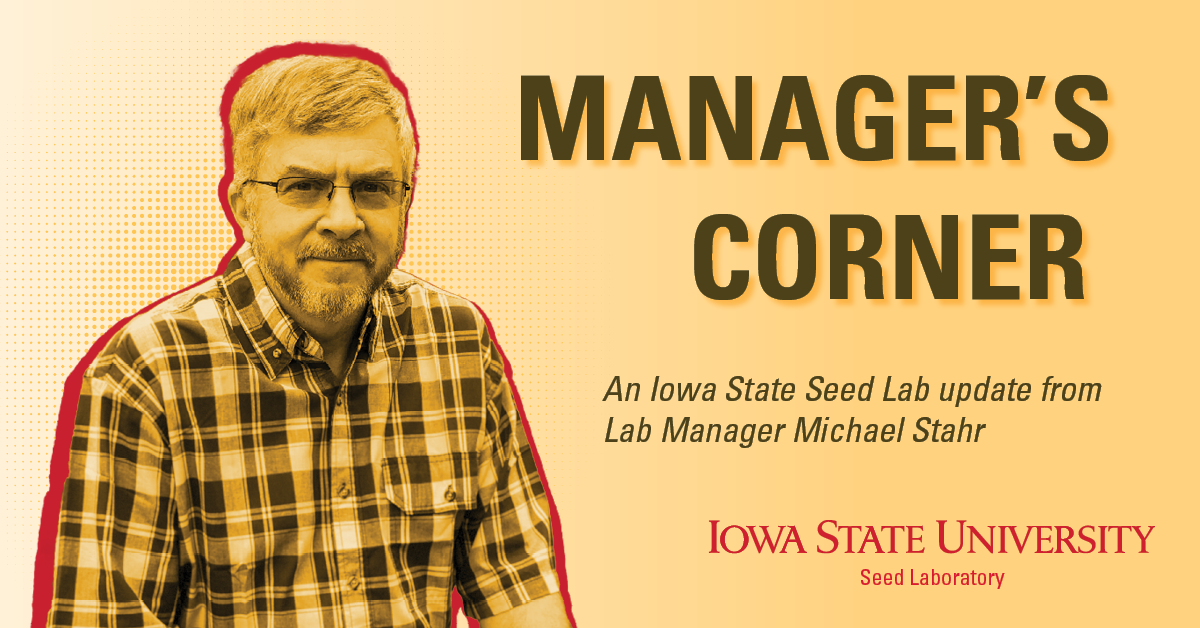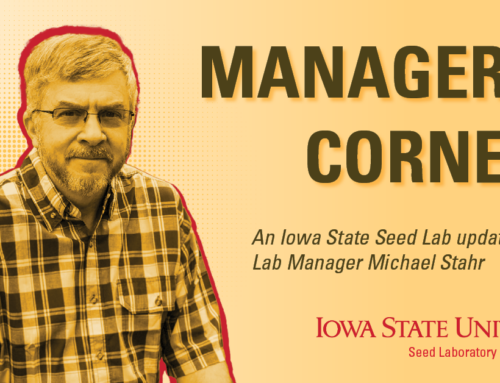In last fall’s Manager’s Corner I focused on renewal – whether the rebirth of plant life in colder climates or the testing of cover crop seed serving as a prelude to the busier winter testing season at the ISU Seed Lab. Little did I know last September that I would experience personal renewal by the replacement of a heart valve via open heart surgery in late December. I could have keeled over when the surgeon told me I would be away from the ISU Seed Lab for ten weeks. In my forty plus years of testing I’ve almost never been away for more than a week. By the end of ten weeks I wondered if I could adjust to working ten hour days testing seed. I returned to doing what I love – seeing seedlings grow, identifying fungi on germination tests, talking to co-workers and interacting with customers – and it was almost as if I never left for my ten week “holiday”.
Farmers and other end users of seed also have to be prepared to deal with the unexpected. Those unexpected occurrences include late frosts, organisms that attack seeds and seedlings, issues with chemicals, equipment issues and much more. Seed testing can eliminate or reduce the effect of unforeseen and foreseen problems. For instance utilizing various vigor tests can prove that a seed lot not only will germinate well in good conditions, but do well in moderate to more severe conditions. Seed health testing can make sure that seeds aren’t carrying pathogens that will hurt the seedlings in the field, but for organisms like White Mold (Sclerotinia), keep a field from having issues for some time in the future. Extension and Seed Lab staff are good sources for information about which tests should be utilized, while information sources like seed lab web sites or search engines (with the ability to detect what is accurate and what may not be) often are.
Part of many seed species’ mechanisms that help ensure a successful renewal (good field stand, etc.) is dormancy. “Mother Nature” is “smart enough” to know that seeds harvested before an ongoing winter better not germinate until suitable growing conditions return. Dormancy may be broken by exposure to cool, wet conditions, to varying temperatures, to light, by further maturing of the seed after harvest, or by other means. Some species that used to routinely have another coping mechanism, hard seeds, have had it bred out to facilitate uniform field stand.
Table 6A in Volume 1 of the AOSA Rules For Testing Seeds tells seed analysts and technologists for more than 800 species which planting media can be used, what temperature options there are, the length of the standard or warm germination test, specific special requirements for some species and finally what to do to break dormancy in species that may have it. Dormancy breaking measures include the use of chemicals (Potassium Nitrate – KNO3, Gibberelic Acid – GA3, Ethylene or Ethephon), prechill or predry, scarification and more. Adding a prechill means placing the planted seeds (on towels, blotters, sand, etc.) in a prechill chamber at 5C or 10C for five, seven or more days and then placing the tests in the correct warm temperature. In today’s world where time is money, an unnecessary prechill means adding to the days until a report of analysis is created. To that end it is important that seed lab staff know if incoming samples contain seeds that are “recently harvested” (Volume 1 Section 6.9e). Often there is confusion on what qualifies as recently harvested. The best bet may be for those sending seed samples to supply the month and year of harvest. If the month is available, then knowing the year of harvest may be helpful.
If it is discovered that dormancy exists in a seed sample, then options include “TZ-ing” ungerminated seeds (using tetrazolium to tell if seeds are dead or if they are dormant) or doing a retest using the proper dormancy-breaking measures. Since customers are anxious for results and lab personnel are busy, the best bet is supplying harvest information.
Summer Workshops: After two successful workshops in April (Advanced Purity and Germination), the focus switches to pretty much weekly conditioning workshops from early June to mid-August. The summer finishes with a Beginner Purity workshop. All workshops have plenty of hands-on, talks supplying useful information and networking opportunities. Please check the Training page on the ISU Seed Lab website (www.seedlab.iastate.edu) for more information.
Best wishes for great summer!


